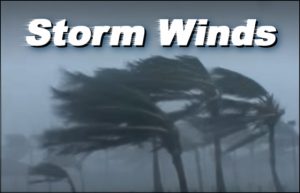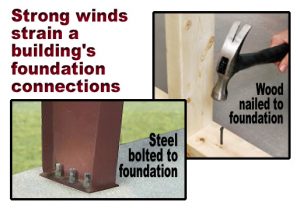J Bolts Agains Lift in Wind Prone Areas
Building to Combat Furious Storm Winds
Pre-engineered steel buildings are designed and engineered to stand up upwardly to damaging winds and other natural disasters.
(As I post this blog, Hurricane Harvey is creeping toward the Texas coast, gaining force over the warm waters of the Gulf. Equally of this posting, Hurricane Harvey'southward winds have reached 110 MPH.)
Which Way the Air current Blows
 Although we typically think of air current damage as resulting from hurricanes battering coastal areas, savage winds can strike anywhere. Hurricane-force winds often extend far inland during major hurricanes. In improver, hurricanes mostly spawn inland tornadoes with even greater winds.
Although we typically think of air current damage as resulting from hurricanes battering coastal areas, savage winds can strike anywhere. Hurricane-force winds often extend far inland during major hurricanes. In improver, hurricanes mostly spawn inland tornadoes with even greater winds.
The mid-section of the U.Southward.— known equally Tornado Alley— is best known for its fierce tornadoes. However, every country in the U.S. experiences some tornadoes.
Sudden downdrafts, derechos, and even howling direct-line winds occur during violent thunderstorms. Northern areas of the country boxing screeching winds during blizzards.
So what is the best way to avoid wind damage?
Edifice with the Force of Steel
With the highest forcefulness-to-weight ratio of whatever building material, steel reigns supreme as the best defense against destructive winds. However, simply being made of steel does non ensure a edifice will withstand ferocious winds. The quality of the steel structure also determines its ability to withstand dissentious winds.
RHINO steel buildings are designed to stand the tests of time and nature. Our structures meet or exceed all current local edifice codes, including wind loads, for the lifetime of the structure— guaranteed.
If the customer requests even greater-than-code current of air resistance, that'due south no problem. RHINO air current resistant construction can exist designed for 170 MPH wind loads— or fifty-fifty college, if desired.
Steel Buildings Provide Stronger Connections
 The nails and staples used in wood framing offer little resistance to gale-force winds. Nether pressure, these fasteners pull out, allowing the roof to fly off and the walls to topple.
The nails and staples used in wood framing offer little resistance to gale-force winds. Nether pressure, these fasteners pull out, allowing the roof to fly off and the walls to topple.
The nails used to secure a typical wood-framed building to the foundation may fail when astringent winds accident. Hurricane-strength winds could lift the entire structure from the slab and turn it to kindling.
Commercial-grade metal buildings assemble with loftier-strength bolts, nuts, and screws that provide much greater resistance to winds. In our air current resistant construction, the columns deeply attach to the foundation with stiff steel j-bolts embedded in the physical.
Stronger Pare
Not all steel buildings are alike. Rhino'south outside steel panels provide greater protection from howling winds iii ways:
- THICKER STEEL: All Rhinoceros metallic buildings include heavy-duty 26-gauge steel exterior panels. Many other metallic building supply lighter 28-gauge steel— or only offer 26-gauge panels as an "upgrade" at an increased price.
- PBR PANELS: The shape of RHINO's Purlin Bearing Rib (PBR) steel panels provides a greater tensile force than past design, outperforming the shallow-depth paneling used by other metallic edifice companies.
- GREATER OVERLAP: RHINO's PBR panels allow a greater overlap between each panel than the cheaply fabricated R-panels of many competitors. Greater overlap means stronger protection from devastating winds.
Beefed Upwards Doors for Extra Protection
Keeping unsafe winds from breaching door openings is critical to a building's survival during a tempest. Wind-rated doors include extra reinforcements to prevent potent winds from crushing doors. Building codes in hurricane-decumbent areas generally require current of air-rated exterior doors. Some customers choose doors with across-lawmaking wind resistance for boosted safety.
RHINO offers a wide choice of attractive wind-rated doors.
Other Ways to Increment Wind Resistance
For more information on designing and locating a safer, more current of air-resistant construction, see Hurricane-Resistant Construction, Role 3.
Call RHINO now to speak to one of our friendly steel building specialists and learn more about our air current-resistant steel buildings. Use our knowledge and expertise to create the best structure for your location. You can reach us at940.383.9566
Source: https://www.rhinobldg.com/how-steel-buildings-resist-wind-damage/